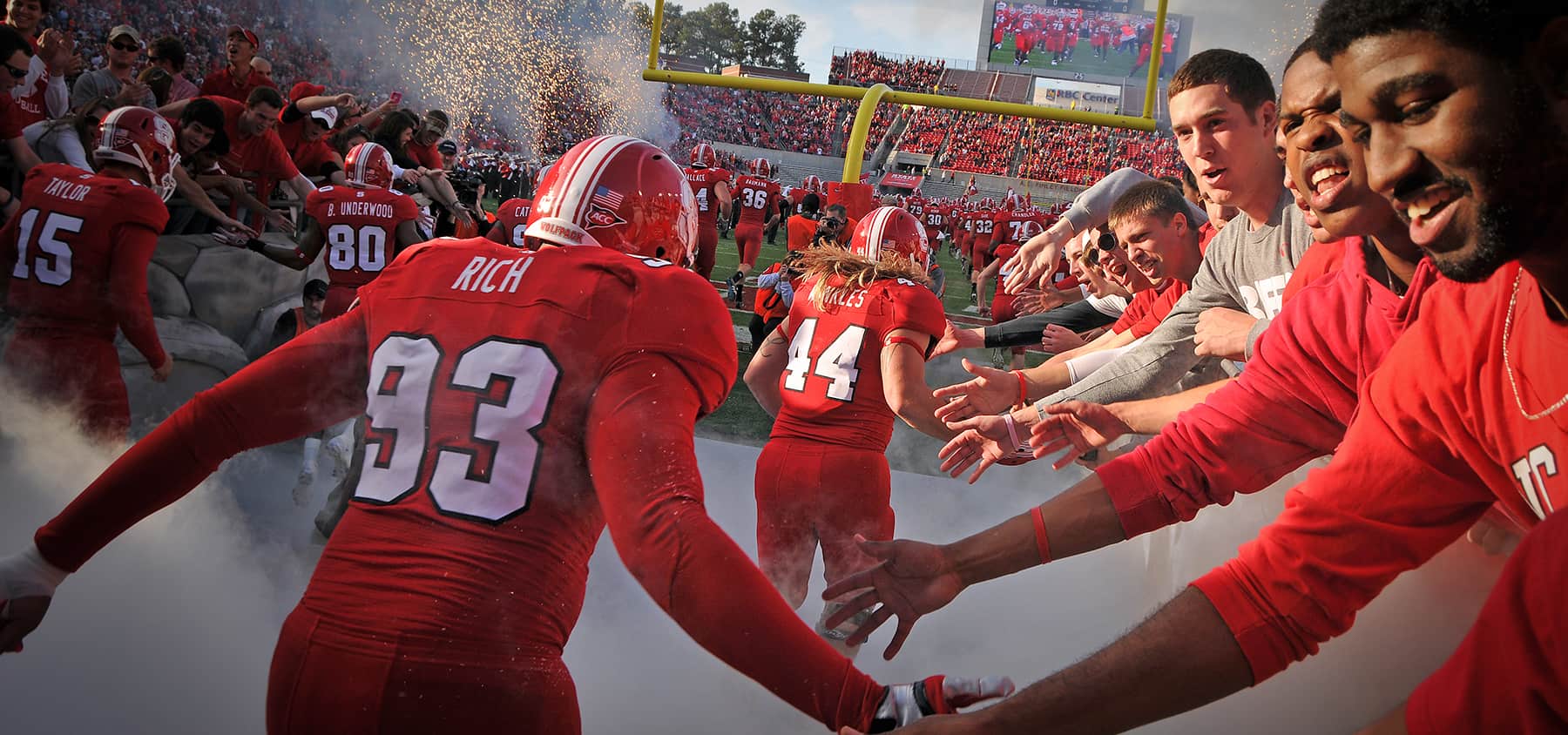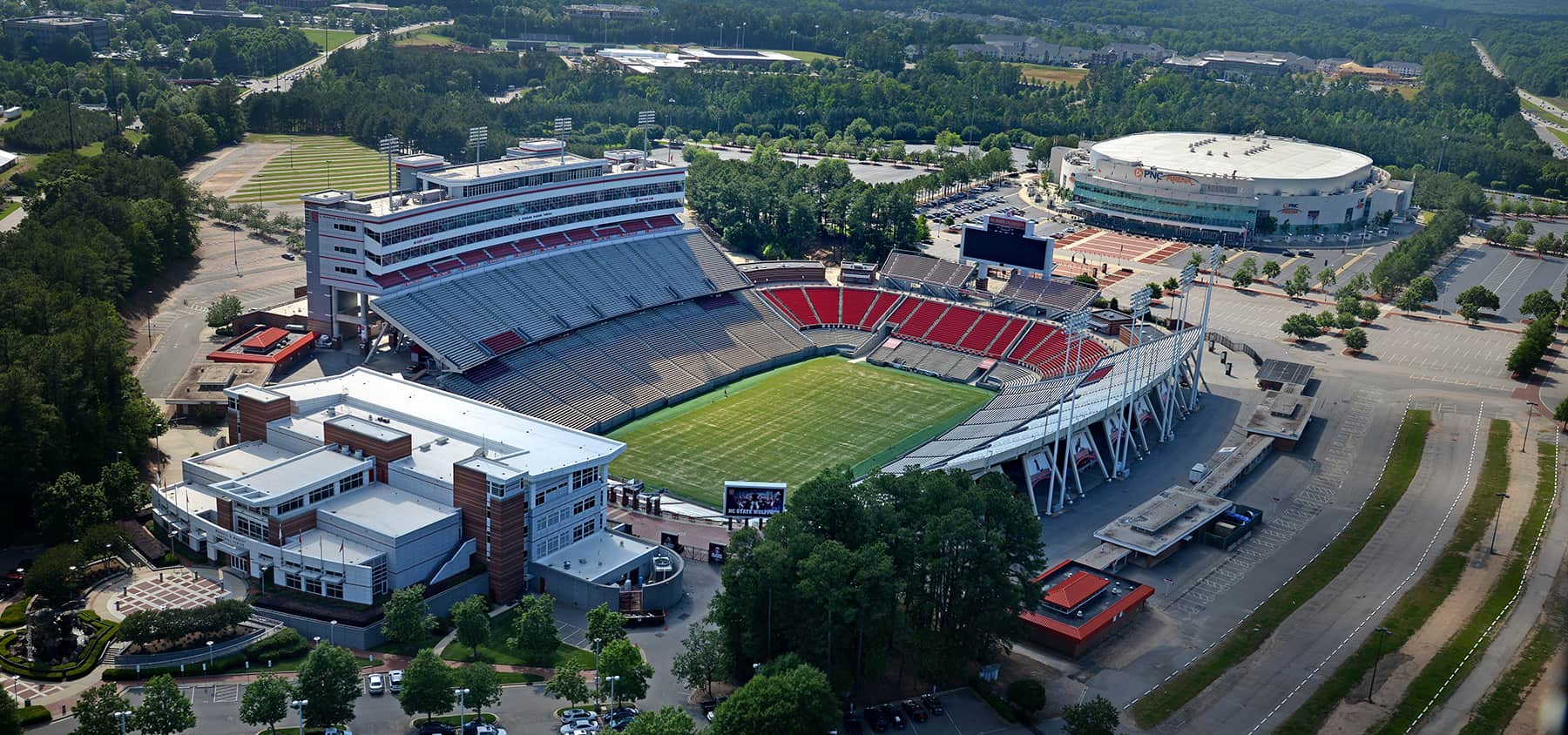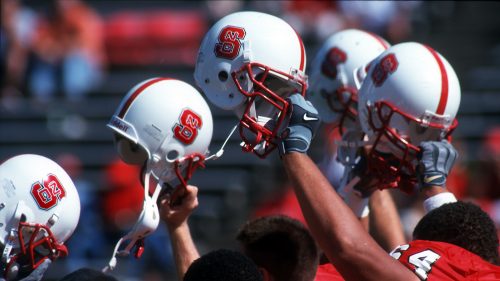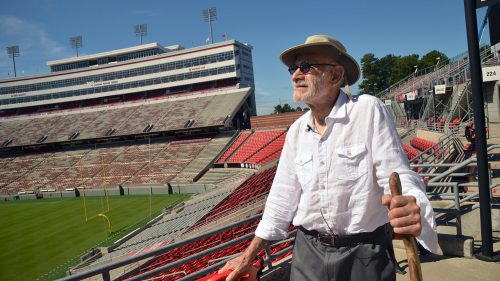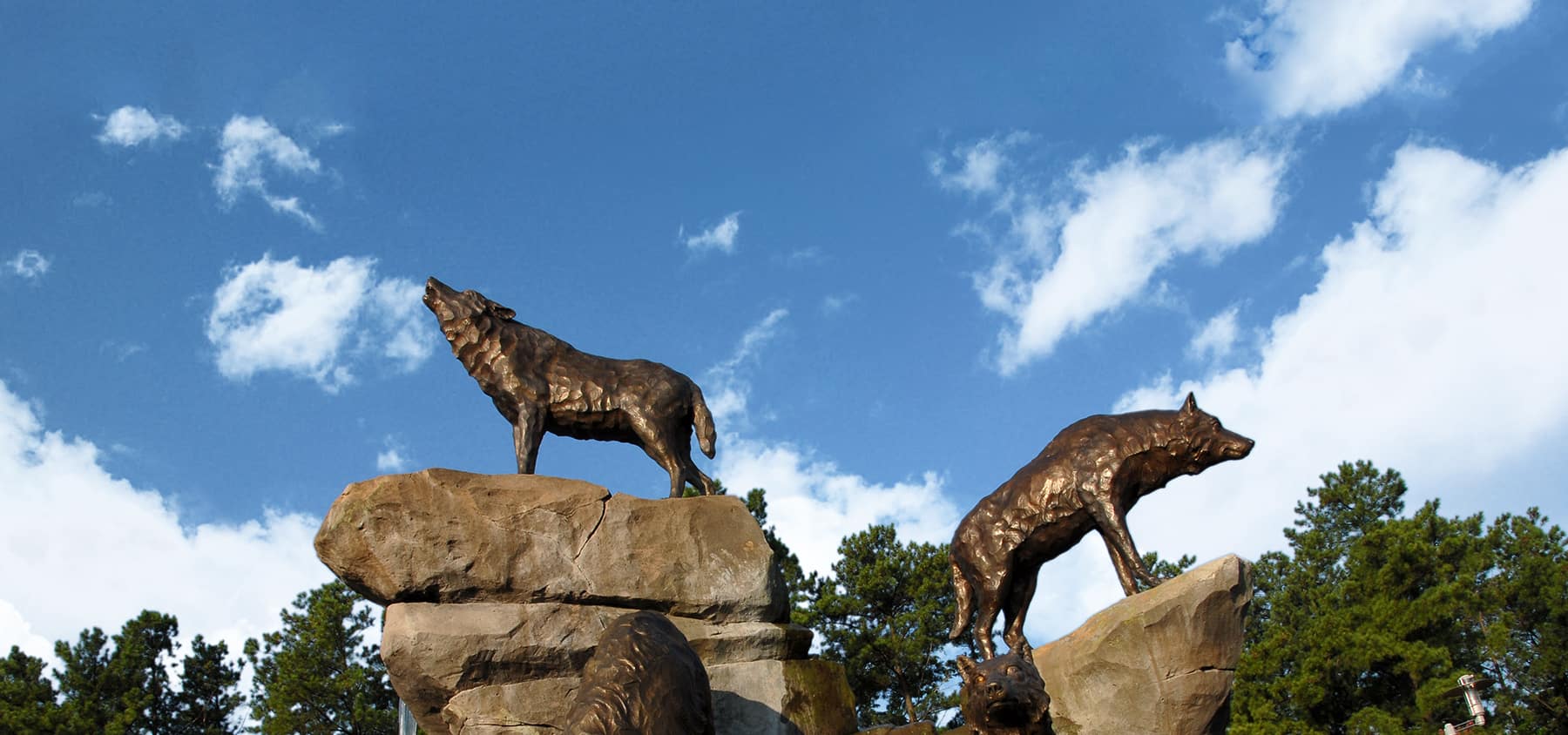

A DEN FOR THE PACK: For the longest time, Carter-Finley Stadium was a dream. Now, it's the perfect home for almost 60,000 NC State fans.

Wolfpack players are as comforted by a rabid sea of red as opposing teams are bothered by it.
Dreams Become Reality
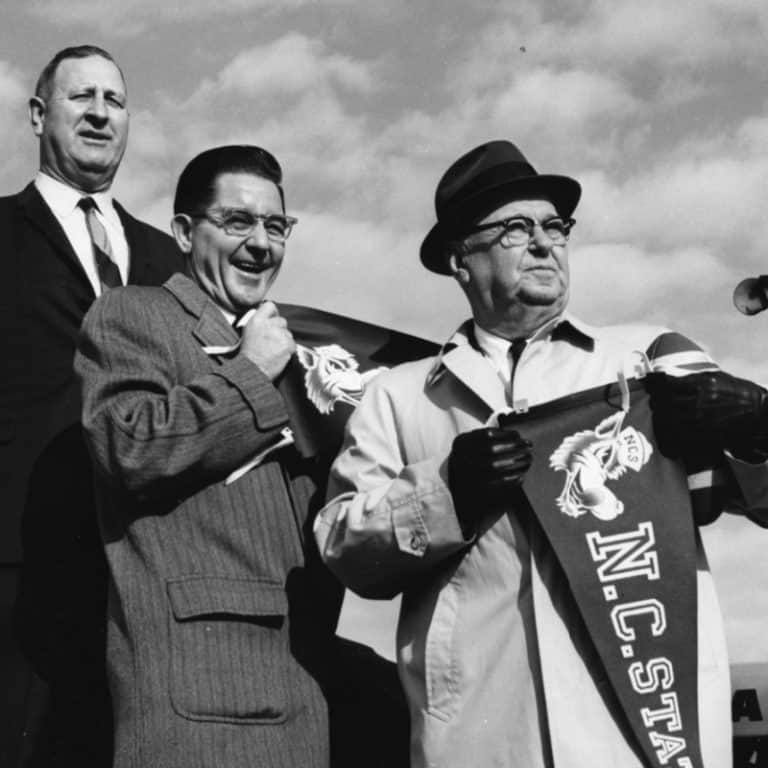
Roy Clogston, William Friday and Walker Martin at the groundbreaking for Carter Stadium
NC State coach Earle Edwards long dreamed of a day when his championship teams could play in a new stadium. That dream began to become a reality in 1962 when the Wolfpack Club and NC State commissioned a feasibility study to develop the details of a new stadium. In December 1964, Chancellor John Caldwell formed a seven-man stadium development committee headed by Raleigh businessman Walker Martin, who owned the nation’s largest General Electric dealership.
Through Walker’s diligent efforts and the support of the Wolfpack Club, nearly half of the $3.7 million needed for construction was raised through private donations. Some 3,000 fans and alumni donated at least $75 to make the stadium a reality, and each of them are recognized in the dedication program.
The other half was financed by the issuance of a 40-year public bond.
The site selected for the stadium was a 75-acre tract of land owned by the university adjacent to the North Carolina State Fairgrounds – reuniting two partners of years gone by.
A lake that had been as a research fish hatchery was drained to help create the bowl of the stadium, while fields of alfalfa hay and corn were plowed under, cleared and leveled to create the expansive parking lots.
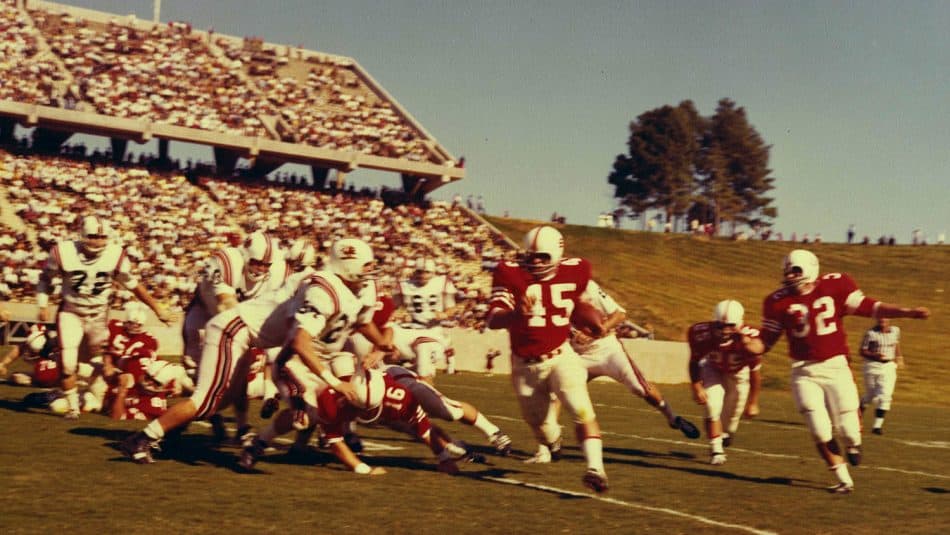
Former NC State design professor Charles Howard Kahn, who owns degrees in engineering and architecture from the school, designed a modernist marvel in 1964 and turned his plans over to L.E. Wooten, another alum and former engineering professor, for his construction engineering firm to build in just 22 months.
The design engineer for the stadium was State College graduate and former civil engineering instructor L.E. Wooten, who owned one of Raleigh’s biggest engineering firm. He hired NC State design professor Charles H. Kahn as the primary designer and Milton Small and Associates as the construction contractor. The erector-set stadium went up at a fast pace, with each of the 16 of the pre-stressed concrete support beams for the upper decks poured on site and the bleacher supports being trucked in from Durham.
“The site…has reverberated a throaty roar of construction,” said the dedication program.
Construction of Carter Stadium – named for brothers Harry and W.J. “Nick” Carter, a pair of NC State graduates from Wallace, N.C. who were successful textile manufacturers – took a little over 22 months, much quicker than the drawn-out process needed to complete Reynolds Coliseum, which was started in 1941, remained a hulking skeleton of steel girders for nearly seven years and only officially opened on Dec. 2, 1949.
Carter Stadium was literally poured into existence after about 300,000 cubic yards of dirt were removed from the site. The unique double-tiered grandstands on the east and west sides required a total of 25,000 tons of concrete, supported by 1,350 tons of steel. Seating capacity was originally listed at just over 40,000.
Less than 10 months before construction was completed, Raleigh philanthropist A.E. Finley and Associates gave $290,000 to finance a fieldhouse in the north end zone, with lockerroom facilities for two 55-player teams.
Photo Gallery: 1965-1969
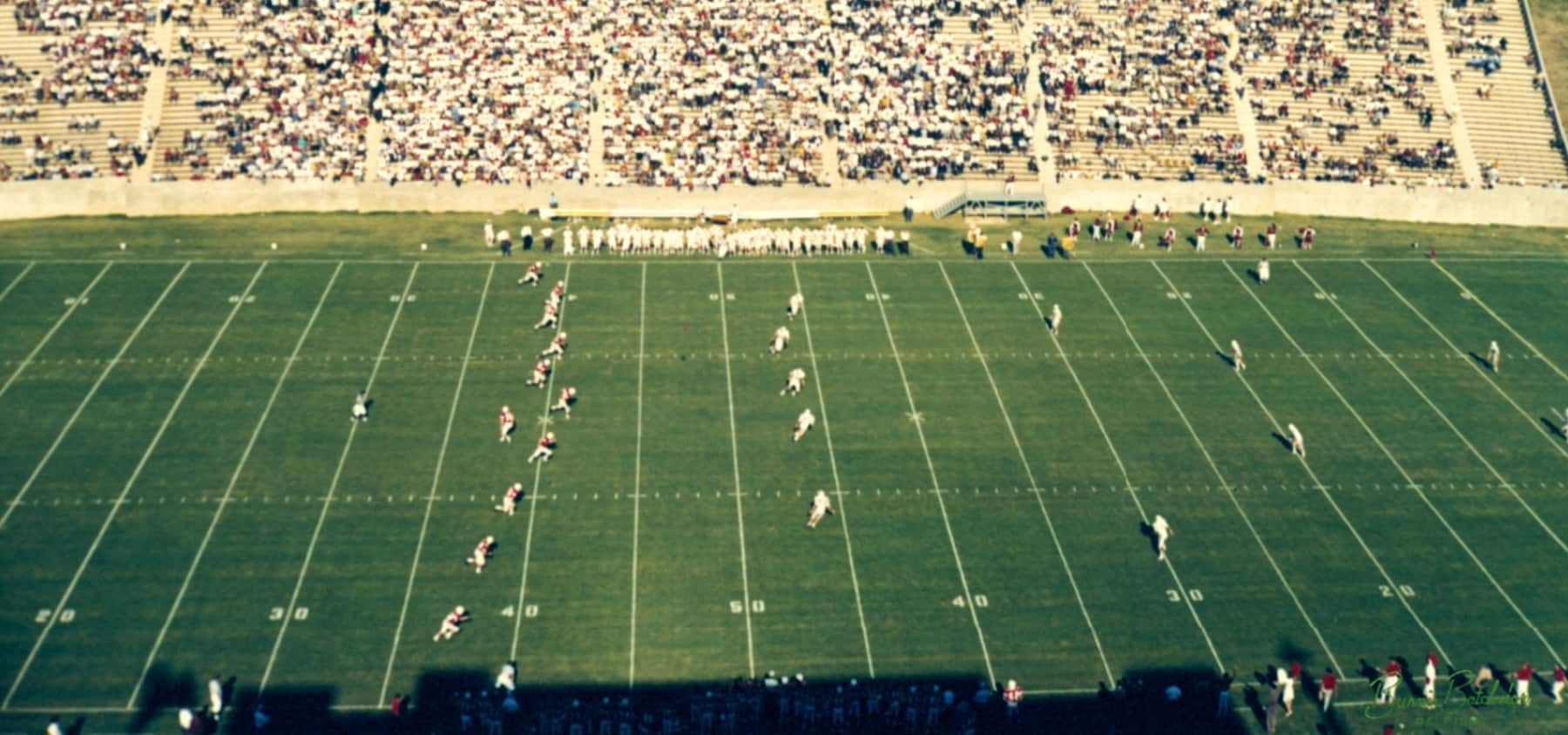
On Dedication Day, according to a newspaper account, "The weather was perfect and the speeches were short. And the mob of 35,200 was well-behaved." South Carolina, however, won the inaugural game 31-21.
A Modern Marvel
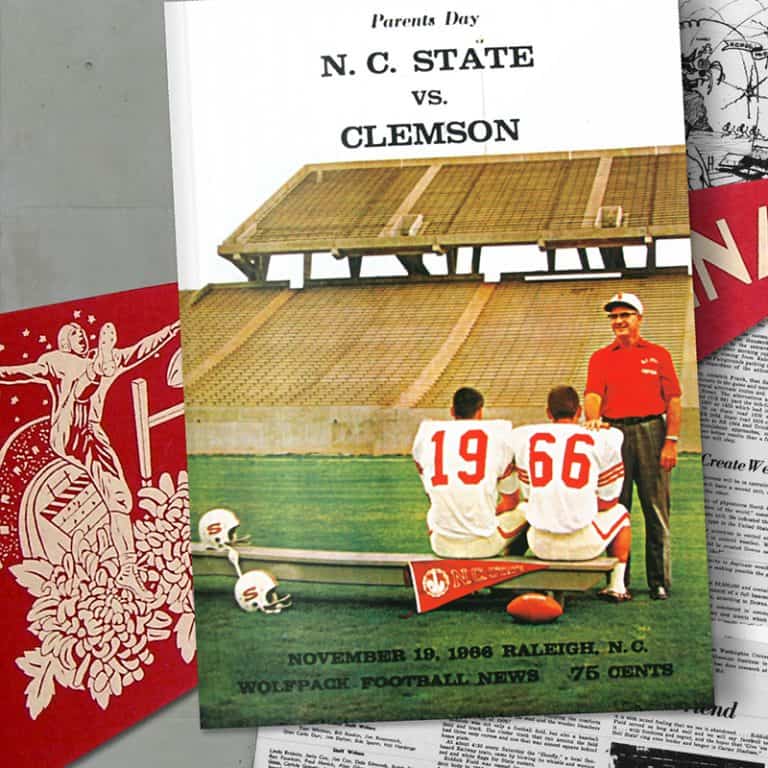
Every game from the 1966 season shared the same classic cover, ushering in a new era of Wolfpack football.
When completed, just in time for the start of the 1966 football season, the new home of NC State football was a modernist marvel, described as a “sleek, 20th-century stadium of rare beauty and functionalism, on a site that will be protected and grow in beauty in the years ahead.”
The three-story press box was described as “plush,” with a full photo deck, five radio broadcast booths, a television production booth and room for 92 writers. Later, it became known as the “double-wide in the sky,” an undersized and under-equipped facility that was replaced in 2004 by the expansive and elegantly appointed Vaughn Towers.
The stadium opened on Oct. 8, 1966, when the Wolfpack hosted South Carolina for Dedication Day. “The weather was perfect and the speeches were short,” wrote a News & Observer reporter. Ultimately, the crowd went home disappointed following a 34-24 loss to a Gamecock team that won only once all season.
But Carter Stadium fulfilled Edwards’ dream, even though the first season had an average attendance of just over 25,500, not much more than the final season at Riddick.

For five decades, NC State has been the place where families and friends from across the state could gather, tailgate and enjoy each other's company — even if they didn't pull for the same team once the game began.
It wasn’t until Lou Holtz arrived in 1972 that the stadium regularly reached capacity.
In four years as NC State’s head coach, Holtz compiled a 20-1-1 record at Carter Stadium, including big wins over North Carolina and the school’s first victory over Penn State. Wolfpack fans filled every seat, plus all the open spaces on the grassy bank of the south end zone, which was used for years as general admission and student seating.
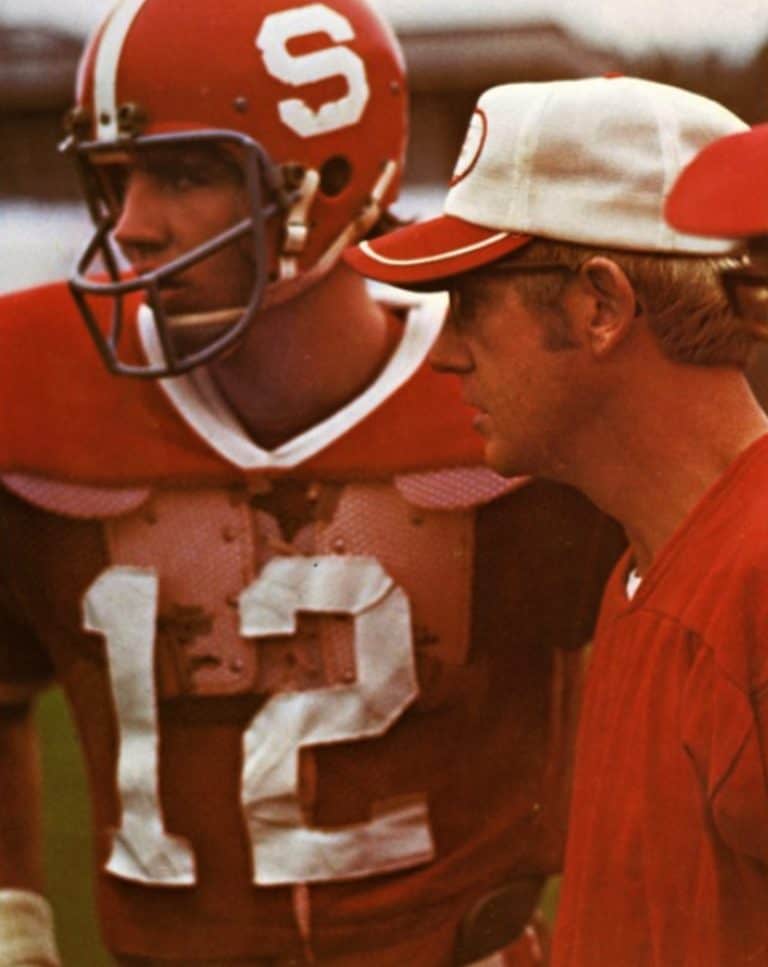
Head coach Lou Holtz lost only once as NC State's head coach at Carter Stadium. When he returned in 1999 to Carter-Finley Stadium as the head coach of South Carolina, his new team was shut out 10-0.
Edwards got the place built, but the success that followed under Holtz and Bo Rein paid for it.
In July, 1978, some 26 years ahead of schedule, the final payment was made on the 40-year bonds that paid for the stadium’s construction. Funding to retire the debt came from football ticket sales, with all proceeds from home games, minus 10 percent for stadium operating costs, going to pay off the mortgage.
Later that same year, a Charlotte architectural firm actually looked into the possibility of enclosing Carter Stadium with a removable roof and additional seating that would increase capacity to roughly 60,000 spectators, at a cost of roughly $30 million. It was designed to be a multi-purpose facility with a Teflon-coated architectural fabric roof that could also host basketball tournaments. Chancellor Joab Thomas called the project “a terrible financial burden” and the idea was never really pursued.
Photo Gallery: 1970-1979
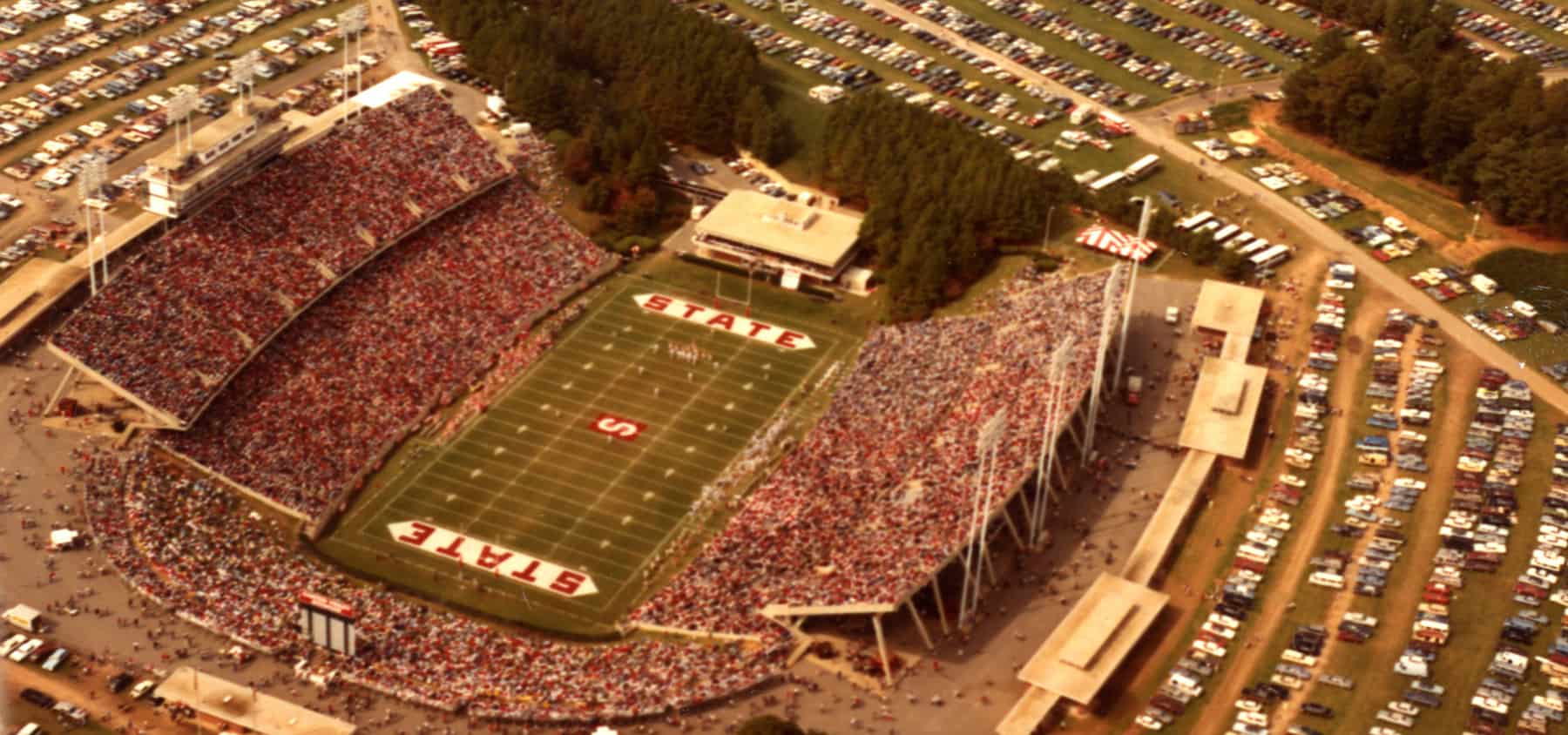
Few changes, other than a variety of field designs like this one from 1983, were made to the stadium from 1966-2000.
Home of Champions
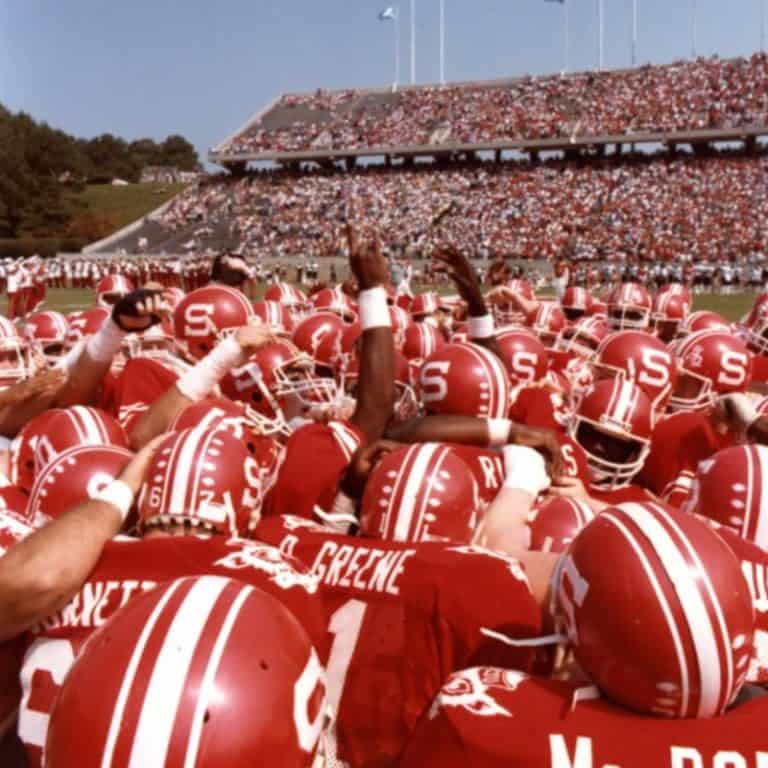
Nothing inspires Wolfpack players quite like the support they get from a Carter-Finley crowd.
For more than three and a half decades after it opened, there were virtually no improvements at the stadium, other than hyphenating its name to honor the many contributions of A.E. Finley in 1979. The only real improvements came as repairs were needed, usually after a visit by rival East Carolina.
Carter-Finley has been the home to some of football’s greatest moments and some of the school’s most decorated athletes: Jim Donnan, Gerald Warren, Dennis Byrd, the Buckey twins (Don and Dave), ACC-career rushing leader Ted Brown, Joe McIntosh, Erik Kramer, Jamie Barnette, ACC-passing leader Philip Rivers, NFL No. 1 pick Mario Williams and future Super Bowl winning quarterback Russell Wilson, just to name a few.
Throughout the 1980s and ‘90s, the school tinkered with plans to upgrade the facilities, kicking off a fundraising campaign in 1993 to raise $45 million by selling seating rights within the stadium. The Gabriel-coached Raleigh Skyhawks of the World League of American Football played there in the summer of 1991, the franchise’s only year of existence.
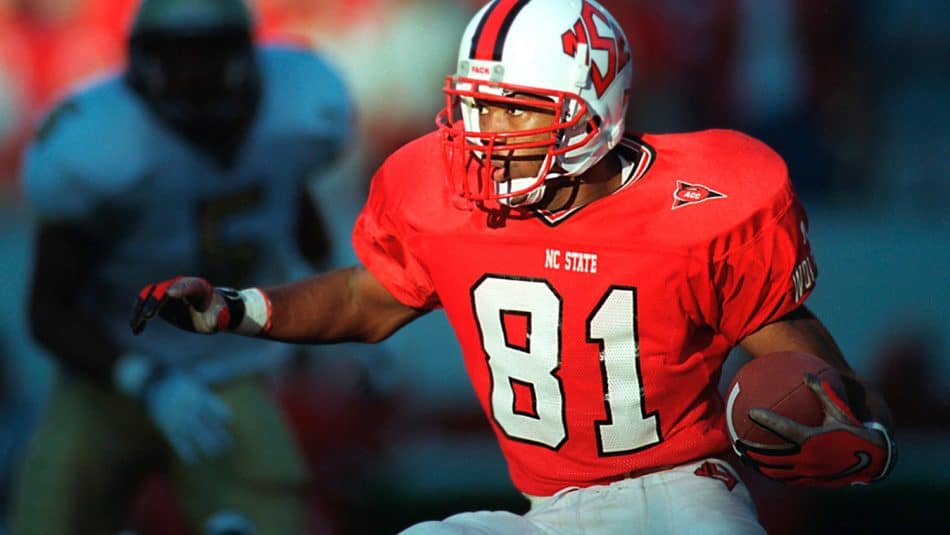
All-America wide receiver Torry Holt scored two touchdowns in the biggest upset in Carter-Finley Stadium history, when the Wolfpack beat No. 2 Florida State 24-7 on Sept. 12, 1998.
Like Reynolds, Carter-Finley has been a multi-purpose facility. The Billy Graham Crusade made a stop here in the earliest days. Concerts — like the 2009 U2 concert and recent appearances by the Rolling Stones and Beyonce — were scheduled on a semi-regular basis since 1979.
The 1987 Olympic Festival Opening Ceremonies were hosted at Carter-Finley, as well as the 1999 World Special Olympics Summer Games Opening Ceremonies. For years, before the RBC Center opened next door, spring commencement ceremonies were held inside the stadium.
But the early 1990s — shortly after athletics director and men’s basketball coach Jim Valvano was forced to resign and football coach Dick Sheridan suddenly retired for health reasons — were difficult times for NC State athletics. The renovation plans languished while the school raised the funds and momentum to help build a new basketball home, the Entertainment and Sports Arena (now known as PNC Arena, at upper right, under construction), which it shares with the State of North Carolina, the City of Raleigh and the Carolina Hurricanes.
Photo Gallery: 1980-1999
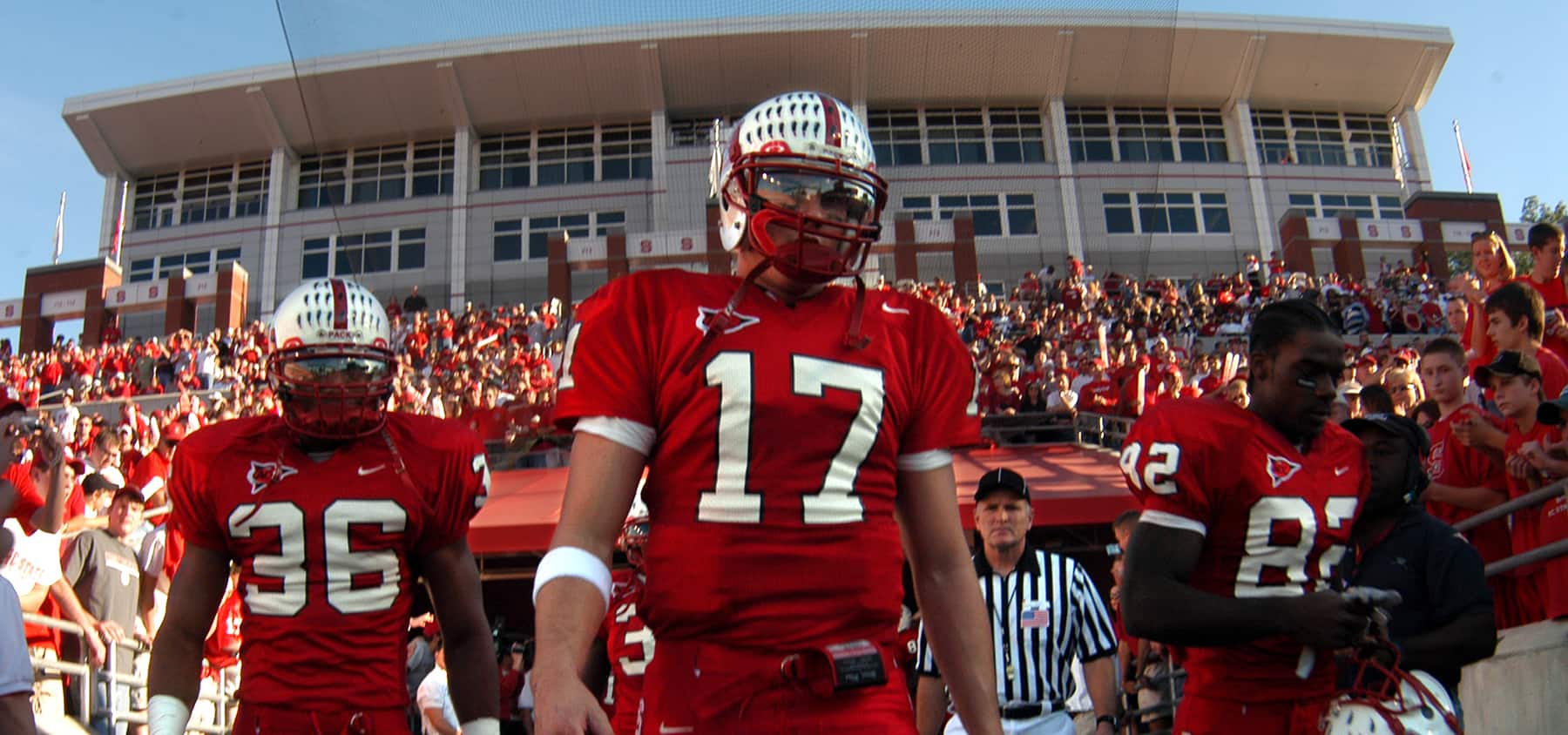
Twenty-six of quarterback Philip Rivers' NCAA-record 51 consecutive starts at quarterback were at Carter-Finley Stadium. His No. 17 is one of 10 honored/retired jersey numbers in Wolfpack football history.
Metamorphosis of a Stadium
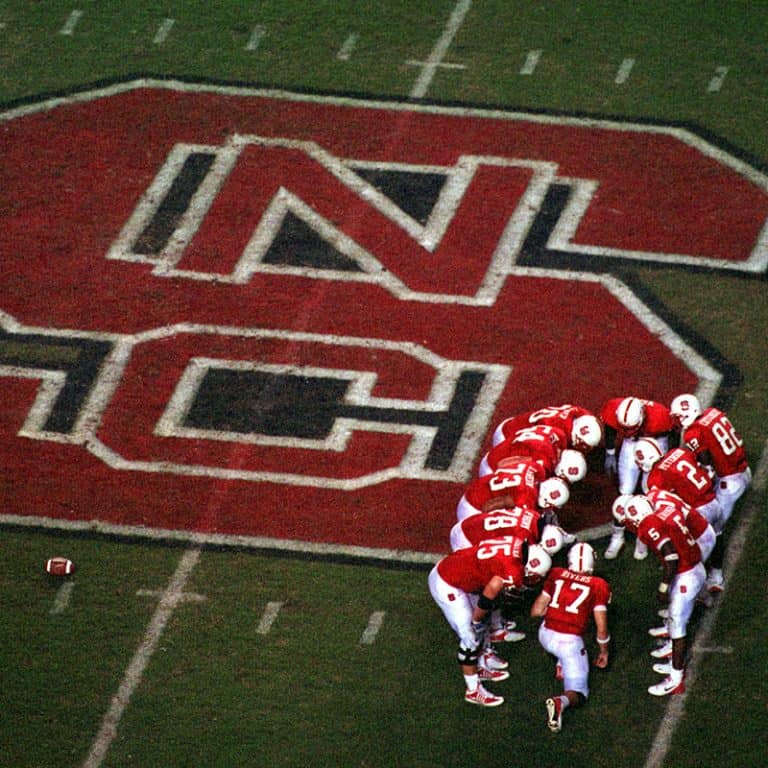
Philip Rivers finished as the ACC's all-time leading passer after guiding the Wolfpack offense for four years.
When Chuck Amato was hired as head coach in 2000, he helped build the momentum for improving the stadium that Edwards, the coach who had recruited Amato and his brother Rosie from Pennsylvania, made a reality.
The first piece of a $100 million renovation project was the Murphy Center, a 108,776-square-foot home for the football program that includes coaches’ offices, a football museum, lockerrooms, weight rooms and a television studio. At the same time, the south end of the stadium where the long-loved grassy bank had been used for general-admission seating since the stadium opened was enclosed with 5,800 chair-backed seats, and three full-sized practice fields were added near the southeast corner of the parking lots.
The old press box was demolished in 2004 to make way for Vaughn Towers, a four-level press box and luxury seating tower that features 51 private boxes and premium seating for some 1,200 season ticket holders.

NC State fans go all-out with the red and white paint as they cheer on the Pack during a game against Western Carolina at Carter-Finley stadium in September of 2010.
In 2006, the original A.E. Finley Fieldhouse was demolished and the North End Zone was enclosed. The $17.3 million project added 5,800 permanent seats atop new home and visiting lockerroom facilities and other storage facilities. Nearly 2,000 bleacher seats were also added underneath the scoreboard, giving the stadium a new capacity approaching 60,000.
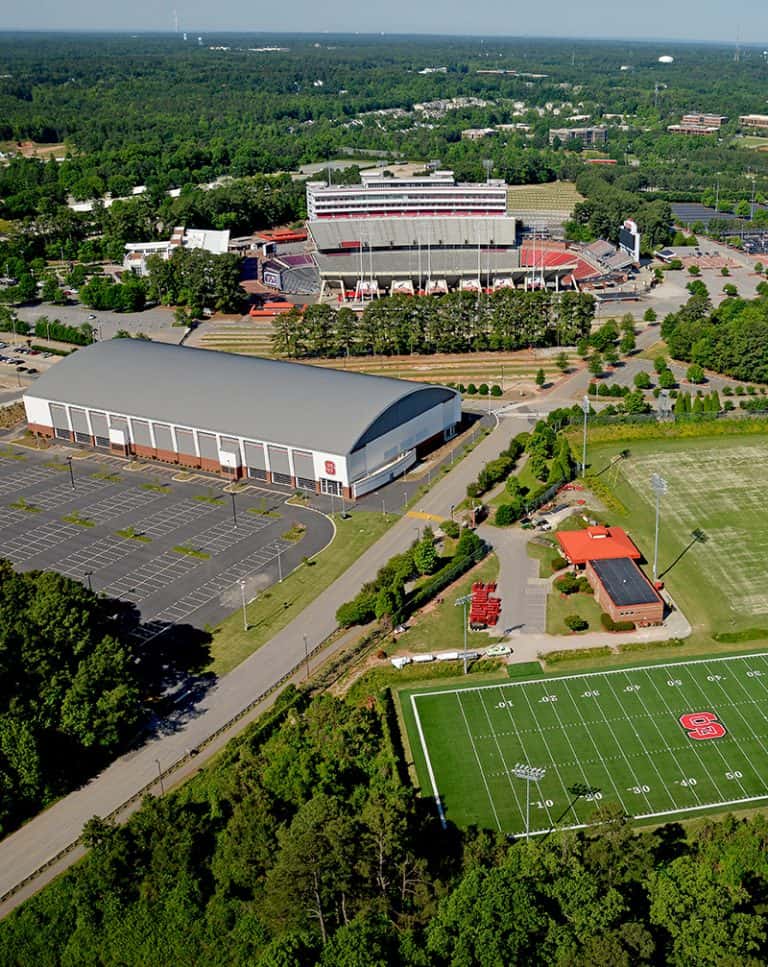
Football complex at Carter-Finley Stadium, including Close-King Indoor Practice Facility and PNC Arena.
The final stage of renovations occurred in the summer of 2009, when the crowned playing surface originally installed in 1966 was replaced with a sand-based, laser-leveled field, and a new irrigation system was added.
In 2015, the Close-King Practice Facility opened adjacent to the stadium and the other three practice fields.
In coming years, future improvements could be made to the east grandstands, but after some 15 years of renovations, improvements and upgrades, Carter-Finley is complete — and up-to-date modern facility that compares favorably with any in the ACC.
Fans are as enamored with the stadium even more than when it opened 50 years ago: Long before the 2016 season began, more than 36,000 season tickets were sold — the most in program history.
Photo Gallery: 2000-Present
